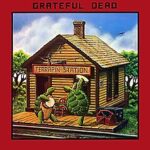by Adam Willis, Seasonal Naturalist

On July 27, 1977, the legendary folk-rock band the Grateful Dead released what I consider to be a very special song. It was titled “Terrapin Station,” and was featured on the album of the same name, occupying the entirety of side two—nearly half of the album’s total runtime. Length alone doesn’t distinguish this song from others by the Grateful Dead. Its psychedelic sound—though very distinctive—isn’t what caught my attention either. There’s something more to it. The Grateful Dead are trying to evoke something extraordinary, and I think the song’s namesake—the terrapin—can lead to some insight.
The name “terrapin” is somewhat misleading—in particular, turtles labeled as “terrapins” aren’t necessarily related to one another at all. Terrapins do not form a taxonomic unit. They can live in different habitats and function in different niches. In fact, they aren’t even limited to one continent, with “species” of terrapin found in North and South America, Europe, Asia, and Africa. With such a confusing descriptor, how is one supposed to know precisely what a terrapin even is? How does this relate to what the song means? Perhaps, it’s best to look elsewhere.

For starters, the turtle is a prevalent symbol seen in many cultures across the globe. A common image in Indian, Chinese, and Native American mythology is the planet Earth being supported by a giant turtle, often on the back of its shell. The Iroquois even referred to North America as “Turtle Island” —such a small creature with such an important task. When looking at the word “terrapin,” it’s important to note its non-English origin. It comes from the word torope: the Algonquian name for the Diamondback Terrapin. Although it isn’t native to Ohio, the Diamondback Terrapin can be found anywhere from Massachusetts to Florida and has one of the largest ranges of any turtle in North America—a very impressive feat for such a small reptile. Something else to consider is its habitat—specifically, its adaptive abilities. The Diamondback Terrapin can live in dramatically different aquatic environments. They are known to live in fresh, brackish, and even open-ocean saltwater. This is all thanks to two unique adaptations: their modified skin, which is impermeable to salt, and specialized salt glands that purge excess salt from their bodies. These features aren’t found in related species, making the Diamondback Terrapin a very dynamic creature.
So, what do these turtles have to do with the Grateful Dead? Why did they decide to name a sixteen-minute song after them—and a whole studio album, no less? For that, I point to these lyrics:
“Inspiration, move me brightly
light the song with sense and color
Hold away despair
more than this I will not ask
Faced with mysteries dark and vast
statements just seem vain at last
“Some rise
some fall
some climb
to get to terrapin”
The “Terrapin Station” that the song is describing is a place home to inspiration. It’s a location thought to be outside the limitations of our surroundings—a safe space where ideas are set free. I propose an interpretation: these turtles symbolize our creativity. Like their odd taxonomy, our creative spirit comes in many different forms, often in ways totally unique from one another. And like their special adaptations, our creativity is resilient; we have the potential to master any task—big or small—no matter the obstacle ahead. And like their massive range and their role in mythology, our creative spirit is determined; we are capable of fantastic things when we dedicate ourselves to the task.
As “Terrapin Station” approaches its 45th anniversary, I think now would be a great time to start making connections with the natural world—even with animals beyond that of the terrapin. Maybe, if we were to dedicate a little time each day to observe and consider the beauty of the environment, we might learn a lesson from those two terrapins on the album’s cover. They dance and play music without a care in the world. Perhaps we should let our inspiration flow like they do: with no hesitation, but with imagination and delight.
Listen to “Terrapin Station” here: https://www.youtube.com/watch?v=e01zTf2tLV0






